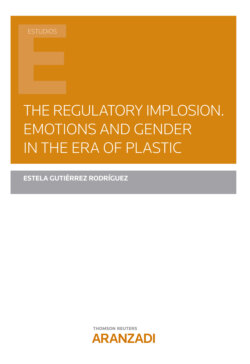Читать книгу The Regulatory Implosion. Emotions and Gender in the Era of plastic - Estela Gutiérrez Rodríguez - Страница 11
На сайте Литреса книга снята с продажи.
2.5. The basel convention
ОглавлениеThe Basel Convention on the Control of Transboundary Movements of Hazardous Wastes and their Disposal, including those materials that contain polluting chemicals such as EDC. It is made, among others, taking into account the United Nations World Charter for Nature22.
The main objective is to comply with international obligations in the protection of human health and the environment. As well as developing technologies that generate minimal waste and promote recycling. The agreement was adopted on March 22, 1989, entering into force on May 5, 199223.
It is interesting that the three conventions are based, on the right that all states have, in accordance with the United Nations Charter and the principles of international law, to benefit their own resources in accordance with their own policies on the matter of environment and development, however it is important that each state manage the waste derived from the use of their resources, especially without harming developing countries. Note that for decades, this has not been the case.
Regulation (EC) No. 850/2004 of April 29, relative to persistent organic pollutants, referred to the need for coordination between the Rotterdam, Stockholm and Basel Conventions within the framework of the United Nations for chemical substances24.
5. Rachel Carson, Silent Spring. New Yorker. September 1962. Ed. digital.
6. COM (1999) 706: Communication from the Commission to the Council and the European Parliament. Community strategy on endocrine disruptors - substances suspected of interfering with the hormonal systems of humans and animals.
7. Nicolas Olea, Maria F. Fernández, “Endocrine disruptors, enough evidence to act?” Gaceta Sanitaria 28, n° 2 (2014): 93-95.
8. A. Rivas, A. Granada, M. Jiménez, F. Olea et. to the. “Human exposure to endocrine disruptors”. Ecosystems 13, no. 3 (2004): 7-12.
9. S. Khetan. Endocrine disruptors in the environment. Op.cit. ap. 1.2.
10. World Health Organization. “Global assessment of the state of the science of endocrine disruptors”. Geneva: WHO, 2012.Acc. August 05, 2020. https://www.who.int/ipcs/publications/new_issues/endocrine_disruptors/en/.
11. UN, Department of Economic and Social Affairs, Sustainable Development Division, “Environmentally Sound Management of Toxic Chemicals, Including Prevention of Illicit International Traffic in Toxic and Dangerous Products”, Agenda 21, Chapter 19.
12. Office for Official Publications of the European Communities. Opinions of the European and Social Economic Committee. “Opinion on: ‘the Proposal for a Council Decision on the signing, on behalf of the European Community, of the Stockholm Convention on Persistent Organic Pollutants’, the ‘Proposal for a Council Decision on the conclusion by the European Community of the Protocol 1998 of the 1979 Convention on Long-Range Transboundary Air Pollution Caused by Persistent Organic Pollutants’, and the ‘Proposal for a Regulation of the European Parliament and of the Council on persistent organic pollutants and amending Directives 79/117 / EC and 96/59 / CE’ ”. Luxembourg, (2008).
13. Arnold Schecter. Dioxins and Health. Including other persistent organic pollutants and endocrine disruptors. Edit. Wiley, (New Yersey), 2012.
14. Regulation (EU) 2019/1021 of the European Parliament and of the Council, of June 20, 2019, on persistent organic pollutants.
15. Persistent organic pollutants are understood to be all those chemical substances that can persist in the environment for a long period of time, accumulate in adipose tissue and can travel long distances either through water, air or through the migration of contaminated species. This being the case, these types of substances have even been found in areas far from normal human activities such as in the habitat of Arctic polar bears. (Among the persistent organics we find some with endocrine disruption capacity, for example, hexabromocyclododecane (HBCD), Fluorine perfluorooctanesulfonate (PFOs), Hexochlorobenzene (HCB), Dichlorodiphenyltrichloroethane (DDT) or polychlorinated biphenyls (PCB).
16. Office for Official Publications of the European Communities. “Environment for Europeans. Big Issues: The Stockholm Convention on Persistent Organic Pollutants. Global control of toxic substances”. Magazine of the Directorate General for the Environment N° 25. 2006 (12).
17. Vid; UNEP the United Nations Environment Program (United Nations Environment Program) founded in 1972 and based in Kenya, for informational purposes, has an exclusive section dedicated to waste and substances chemical POPs. Program, United Nations Environment. Persistent Organic Pollutans (COPs), 2017. https://www.unenvironment.org/explore-topics/chemicals-waste/what-we-do/persistent-organic-pollutants-pops. Acc. August 5, 2020.
18. Mario Yarto, Arturo Gavilán, et. to the. “The Stockholm Convention on persistent organic pollutants and its implications for Mexico”. Ecological Gazette 69, (October-December 2003): 7-28.
19. Program, United Nations Environment (UNEP), Persistent Organic Pollutans (COPs), “Why do chemicals and waste matter?” https://www.unenvironment.org/es/node/1165. Acc. August 10, 2020.
20. United Nations Environment Program (UNEP), Food and Agriculture Organization of United Nations (FAO). Rotterdam Convention. “Rotterdam Convention on the Prior Informed Consent Procedure Applicable to Certain Pesticides and Hazardous Chemicals Moving in International Commerce”. 2017. http://www.pic.int/ElConvenio/Generalidades/TextodelConvenio/tabid/1980/language/esCO/Default.asp.Acc. August 20, 2020.
21. Jeadran N. Malagón-Rojas, Carolina F. Garrote-Wilches, et. to the. “A debt from the past: effects of organochlorines on workers of the vector control program - Colombia”, Magazine of the Industrial University of Santander, Salud Vol. 46 No. 3 (September - December 2014): 227-235.
22. Angel J. Rodrigo Hernández, “The mechanism to promote the implementation and compliance of the Basel Convention on the control of transboundary movements of hazardous wastes and their disposal, 1989”. Spanish Journal of International Law, 55 (2003): 1090-1096.
23. Manuel Pérez González, Towards a new international and European order, edit. Technos. (Madrid, 1993).
24. Regulation (CE) n° 850/2004, of the European Parliament and of the Council of April 29, 2004 on persistent organic pollutants and by which Directive 79/117 / CE is modified, (DOUE n°, L158 of April 30, 2004).
